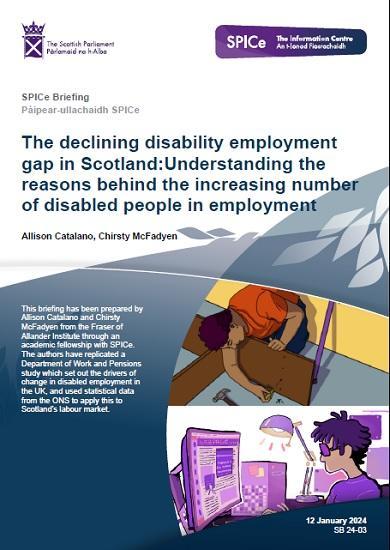Why Is The Gap In Employment Between Disabled And Non-disabled People In Scotland So Large?
13th January 2024

Back in September, Fraser of Allender published some initial findings on the disability employment gap in Scotland, in collaboration with the Scottish Parliament Information Centre (SPICe).
This blog looked at the ways in which the gap in employment rates between disabled and non-disabled people has changed since 2014, finding that Scotland has lower rates of employment for disabled people compared to the rest of the UK. The gap has been closing more quickly, however.
This initial research led us to a question: why has the gap been closing more quickly? And furthermore, what changes have happened for different groups of people with disabilities?
Our full report, published today, models the reasons behind this change, and explores more detailed statistics on employment differences by type of disability. Our work is based on a previous report by the DWP which looked at changes in the disability employment gap across the UK.
Some of our key findings include:
The employment rate for disabled people in Scotland has increased by 9 percentage points since 2014. Non-disabled employment rates also increased by 3 percentage points during this time period. This increase in the employment rate has been larger in Scotland compared to the rest of the UK, although the employment rate remains lower.
The employment rate has largely increased due to an increase in disability prevalence (70% of the total change), meaning that this change is primarily due to working people becoming disabled. A small portion of the change (10%) was due to a change in working patterns among disabled people.
On average, Scotland's disabled working age population grew by about 4.6% each year between 2014 and 2022, while Scotland's total working age population grew by less than 0.1%
Over half of the change in disability prevalence is due to an increase in reporting mental health-related disabilities and learning difficulties. In 2014, over a third of disabled people in Scotland reported musculoskeletal conditions as their main issue, and around a quarter reported a mental health condition or learning difficulty.
These proportions have now switched.
Employment rates for all types of disability have increased since 2014. Musculoskeletal conditions - those affecting arms, legs, feet, neck, and back - had significant increases in employment rates, without significant increases in disability prevalence. By comparison, rates of reported mental illness grew substantially in both employment rates and in total prevalence, although the change in employment outpaced the change in population size.
Disabled people are disproportionately less likely to work in manufacturing; professional, scientific, and technical activities; or construction, and are more likely to work in education, retail, and health and social work.
Read the full report HERE
Pdf 34 Pages
